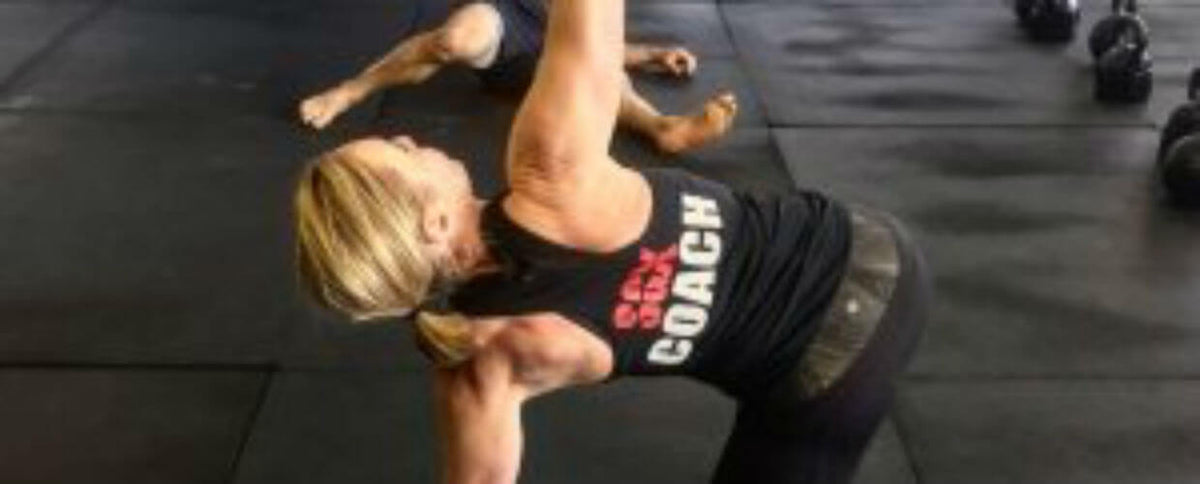Turkish Get-Up: 9 Reasons You Want to Master This Exercise

Want ridiculous strength to conquer all Spartan obstacles while at the same time “bomb-proofing” your body from injury? Then say hello to the Turkish get-up.
Turkish Get-Up Background
The Turkish get-up is traditionally done with a kettlebell, but it can be done with dumbbells, sandbags, barbells, and even a fellow human! Legend has it that when old-time strongmen were asked to take on an apprentice, they would send the applicant away, telling him not to return until he could perform one Turkish get-up using a 100-pound weight.
It is also believed that ancient wrestlers in what is now Turkey invented the get-up to prepare for their grueling competitions. History also reports that Turkish Janissaries used the get-up as a part of their strength training regimen. Russian soldiers used kettlebells to prepare for war. It made them strong and provided them with the endurance they needed for battle. And now you too can use the Turkish get-up as a way to prepare for a Spartan race.
Related: This 1 Exercise Burns 400 Calories
Regardless of where the Turkish get-up originated, it is often neglected or dismissed by people who do not understand how to do it or what it can do for the body. However, once you learn the movement, the benefits are mind-boggling.
To start with, it exposes weaknesses and imbalances. The Turkish get-up enables you to identify asymmetries between the left and right side of your body. For runners, this is a huge injury-proofing benefit. Once you dial in this movement and each of its steps along the way, you will start improving your overall mobility, stability, and the often-overlooked time under tension.
The get-up gives instant feedback as to what you need to work on. Think about this for a moment. The get-up requires you to hold one arm in a stable overhead position while moving through multiple planes of motion, finding points of stability in the anterior, lateral, and overhead positions, all while supporting yourself with one hand and transitioning from lying to kneeling to standing. So if you crawl under barbed wire for 100 yards or carry a sandbag for 15 minutes, you will want these key benefits.
Related: 7 Common Fitness Myths Debunked
9 Benefits of the Turkish Get-Up
If you break down the movement and do it correctly, you will see it has much to offer:
- a primitive rolling pattern,
- unilateral development,
- a lunge pattern,
- an overhead hold,
- two hip hinges,
- glute activation,
- core recruitment,
- improved leg drive, and
- rotator cuff stabilization.
Exceptional For Overall Mobility
When you add all of the Turkish get-up benefits up, it is unbelievable for overall mobility and stability of the core, shoulders, and hips. No other single exercise can do all of this.
When the Turkish get-up is loaded, to what you consider heavy, you will develop ridiculous strength. Heavy get-ups improve your strength in many ways, but one of the most important ways is by teaching the important skill of “linkage” while eliminating strength “leakage.”
According to physical therapist Gray Cook, “Stabilizers are what give you the mechanical advantage to be stronger.” Heavy Turkish get-ups improve your stabilizers, which will improve your linkage, and simply put, more linkage equals more strength.
This beautiful thing about linkage is that it is a skill that transfers very well to all hanging obstacles, like monkey bars, multi-rig, and many others. Who wouldn’t want more of this kind of strength, right?
For me, the Turkish get-up is learning to move strong with controlled coordinated movements. I simply consider it loaded yoga.
Related: 5 Best Stretches for Spartans
Ready to revamp your life and fitness routine? Sign up for a Spartan Race today!
How to Do the Turkish Get-Up
My advice. Slow down. Breathe. Practice bodyweight only. Then, try a shoe on top of a closed fist. Next, try a light load (start using a kettlebell here). When you’re ready, go heavy.
https://youtu.be/3oWPKg88vgU
Setup:
- From the fetal position, roll onto your back. (If using a kettlebell, keep it close to your body with two hands.)
- Extend your right arm (arm that holds the load) and bring your right heel close to your butt.
- Align your other limbs to 45 degrees off your spine.
- Keep a neutral wrist throughout the movement.
Movements:
- Drive through your right heel and roll to your left elbow. Get tall.
- Push the floor away with your left palm (without hopping) to sit tall.
- Sweep your left leg under your right leg and behind you until your left hand, left knee, and left foot are in a straight line.
- Sit on your left heel (hip hinge) and go into a tall kneel. Look straight ahead now.
- “Windshield wiper” your left leg around until you are in a lunge position.
- Stand up . . . I mean . . . get up.
- Reverse the instructions and do a get-down.
- Repeat with the other side of your body.
Tips:
- Keep your eyes glued to the hand that is holding the kettlebell (or shoe, bell, human, etc.) at all times when the other hand is touching the ground.
- When your supporting hand is off the ground, look straight ahead.
If you want to up your obstacle-course racing game, then include the Turkish get-up in your training. It is one of the best exercises out there for injury prevention and strength. I highly recommend that you learn how to do them correctly. As Joe DiStefano, director of sport and training for Spartan race said: “The get-up. If you aren’t doing it, you better start. If you are doing it, do it more or do it better. It could be the single most effective bomb-proofing you do this race season.”
Minimal gear and time. Maximum effect. Download the Get Fit Fast training program




